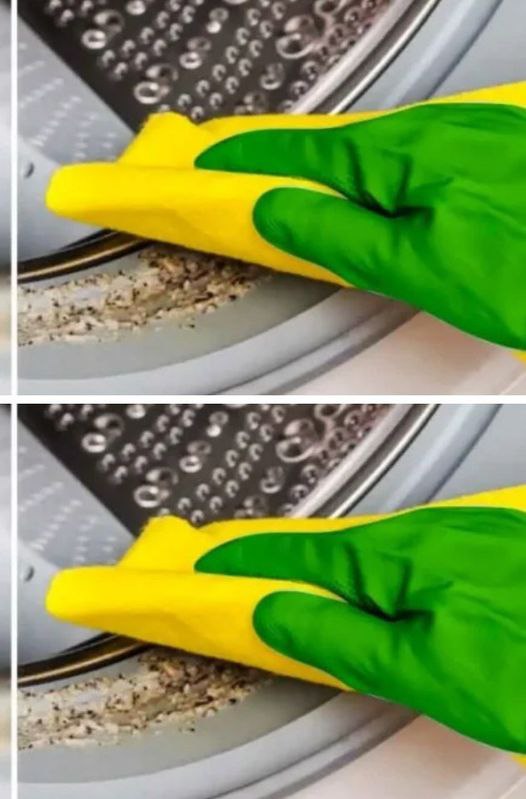ADVERTISEMENT
What You’ll Need:
- White vinegar (natural disinfectant)
- Baking soda (for scrubbing away grime)
- Microfiber cloth or sponge
- Toothbrush (optional, for scrubbing smaller areas)
- Hot water
1. Clean the Drum and Gasket
Start by inspecting the drum and rubber gasket (the rubber seal around the door, especially in front-load machines). These areas are prone to mold and mildew buildup.
- For Front-Loading Machines: Wipe down the gasket with a microfiber cloth dipped in a mixture of hot water and vinegar. This will help break down any mold and remove lingering grime. Don’t forget to check around the edges of the gasket, where water and detergent may have accumulated.
- For Top-Loading Machines: Open the lid and inspect the inside of the drum. Use a microfiber cloth or sponge soaked in hot water and vinegar to wipe down the inside, focusing on the edges where detergent and dirt may build up.
2. Run a Hot Cycle with Vinegar
Once the visible grime has been cleaned, it’s time for a deep clean. Fill the washing machine with hot water (using the largest load setting) and add 2 cups of white vinegar. Vinegar is a natural disinfectant that will help break down soap scum, bacteria, and mold while also eliminating bad odors.
- For Front-Loading Machines: Run the cycle without any laundry inside, allowing the vinegar solution to soak the drum and gasket. This will clean and freshen the interior.
- For Top-Loading Machines: Let the washer fill with hot water, then pause the cycle after a few minutes to let the vinegar solution sit for 30-60 minutes. After that, resume the cycle to complete the wash.
3. Scrub Away the Grime
While the machine is soaking, take a toothbrush or a soft scrub brush and gently scrub any remaining stubborn spots in the drum, around the agitator (for top loaders), and around the door or lid area.
Use a mixture of baking soda and water to create a paste and apply it to any areas with visible grime or soap scum. This paste will gently scrub away residue without damaging the machine.
4. Run Another Hot Cycle with Baking Soda
After the vinegar cycle is complete, add 1/2 cup of baking soda directly into the drum (without any laundry) and run another hot wash cycle. Baking soda helps neutralize odors and gives the machine an extra clean boost by breaking down any leftover soap scum.
5. Clean the Detergent Drawer and Filter
Over time, detergent residue and fabric softener can accumulate in the detergent drawer or filter, making the washing machine less efficient.
- For Front-Loading Machines: Remove the detergent drawer and clean it thoroughly with warm soapy water and a brush. This will help remove any residue that could cause blockages.
- For Top-Loading Machines: Check and clean the filter (usually located at the bottom of the tub). Follow your manufacturer’s instructions to remove and clean it.
6. Wipe Down the Exterior
After finishing with the inside, don’t forget to clean the exterior of the washing machine. Wipe down the surface with a damp cloth and a small amount of vinegar to remove any dirt or dust. Don’t forget the knobs and control panel—these are often overlooked but can accumulate grime as well.
How Often Should You Clean Your Washing Machine?
- Monthly: For optimal performance, aim to deep clean your washing machine at least once a month. This will help prevent the buildup of soap scum, detergent residue, and unpleasant odors.
- Regular Maintenance: Between deep cleans, it’s a good idea to leave the washing machine door or lid open after each use. This helps air out the interior and reduces moisture buildup that can lead to mold.
Energy-Saving Tips for Your Washing Machine
Cleaning your washing machine doesn’t just improve its performance—it can also help lower your energy bill. Here are some additional tips for saving energy:
- Use Cold Water: Washing clothes in cold water reduces the energy used to heat the water, which can account for a significant portion of your electricity bill.
- Don’t Overload: While it may seem like a good idea to wash as much as possible in one load, overloading the machine can cause it to use more energy to agitate and rinse. Aim to wash full but not overloaded loads.
- Choose Shorter Cycles: Many newer washing machines offer shorter wash cycles that still provide a thorough clean. These cycles use less water and electricity, making them more energy-efficient.
- Maintain the Machine: A well-maintained machine runs more efficiently. Regular cleaning and occasional maintenance (like checking hoses for leaks or replacing filters) ensures the machine doesn’t work harder than it needs to.
Conclusion
Cleaning your washing machine regularly is essential to keeping it running efficiently and saving on your electricity bill. By following these simple steps—using vinegar, baking soda, and a little elbow grease—you can remove built-up grime, keep your washing machine fresh, and improve its performance. Plus, with proper care and maintenance, your washing machine will last longer, ensuring you get the most value out of your appliance.
So, next time you think about skipping a cleaning session, remember that a little effort now will save you money in the long run! Your clothes will thank you, and your electricity bill will, too.
ADVERTISEMENT
